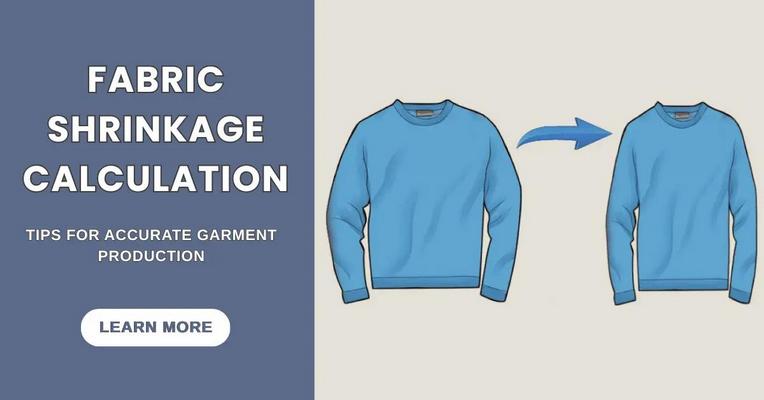Fabric is the foundation of the material building on which the manufacturing company depends. It is important to pay attention to the fabric’s quality and proper techniques of manufacturing. Otherwise, you might have to face problems like fabric shrinkage. In this article, you will learn everything related to fabric shrinkage and how you can control shrinkage.
What is Fabric Shrink?
Even after many washes, a fabric can shrink. The fabric will shrink regardless of the methods of washing. The shrinkage can change the shape and size of the fabric and you might have difficulties wearing them.
Why Fabric Shrink?
One of the most common reasons for fabric shrinkage is that garments are made of low-quality fabric or unstable fibers. Manufacturers often use cheap fabrics at low prices to increase their profits. These products lack proper finishing and lack good quality materials which often results in shrinkage. These types of fabrics are prone to shrink or lose color after a few washes. Even though the fabric is of good quality, it doesn’t mean that it will not shrink. If the fabric is put under rough washes, excess heat, and moisture can cause the fabric to shrink.
There are mainly two types of fabric Shrinkage:
- Contraction: The fabric tends to spread in different areas in different directions.
- Expansion: The overall length and width are shortes.
Fibre Material Shrinkage Calculation
You can calculate the fabric shrinkage calculator through different test methods. These methods often include hand washing or machine washing the fabric. You get to measure the fabric before and after the wash and check to see shrinkage. If the shrinkage rate is between 2-3%, it gets approved. Below are some test methods that help you calculator the shrinkage:
- AATCC 135
- AATCC 150
- Iso 6330
- CGSB 58
For manual calculations, you can use the below formulas:
Lengthwise Shrinkage % = [ ( Fabric Actual Length – Final Length) ÷ Original Length ] × 100
Widthwise Shrinkage % = [ ( Fabric Actual width – Final width) ÷ Original width ] × 100
Fabric Shrinkage during Manufacturing
Washing process: The finished products from the garments have to go through a washing process followed by laundry techniques. Based on the fabric type, the fabrics are supposed to shrink about 3-5% after the wash.
Dyeing process: The fabrics undergo various drying processes which include warm water, high heat, and industrial chemicals. If the fabrics haven’t stabilized, they are supposed to shrink about 5-7% after this process.
Common Fabrics and Their Shrinkage
| Fiber Type | Shrinkage Rate |
| Cotton | 3-7% |
| Linen | 4-10% |
| Silk | 2-4% |
| Wool | 4-10% |
| Rayon | 5-8% |
| Viscose | 5-7% |
| Jute | 3-5% |
| Banana Fiber | 3-6% |
| Coconut Fiber | 4-7% |
| Milkweed Fiber | 2-5% |
| Lotus Fiber | 2-5% |
| Lyocell | 2-4% |
| Sisal | 4-10% |
| Kapol | 3-5% |
| Kenaf | 3-7% |
Fabric Shrinkage Control
Since the fabrics can shrink after a few washes, manufacturers need to control the shrinkage. Below are some of the methods that will help you control shrinkage.
- Manufacturing: Prioritize using high-quality fibers since they have low tension. Maintain a minimum yarn tension to prevent excess shrinkage.
- Pre-shrinking: Make sure to preshrink the garments by using optimum heat settings, and fabric softening processes.
- Moisture: Environmental factors also affect the shrinking process. High humidity will increase the fabric shrinkage so maintaining an environmental temperature is important.
- Thermoplastic: For synthetic fibers, use heat to shrink the fabric to its limit and then use a cool temperature to lock the fibers.
Synthetic Fibres vs. Natural Fibers
| Synthetic Fibres | Natural Fibers |
| Synthetic fibers like nylon and polyester have a low shrinkage rate which is under 2%. | Natural fibers like cotton, wool, linen, and rayon have consistent or high water absorption which means they can shrink greatly. |
| These thermoplastic structures can stop fabrics from shrinking. | The fabric is prone to shrink even after multiple washes. |
Conclusion
To know the shrinkage, it is important to ensure you pick the correct fabric type. The shrinkage fabric depends on the fabric type. Depending on the fabric, you are likely to see 2-3% shrinkage after the testing period. Any higher percentage than this could mean the fabric is not suitable for consumers. Pre-shrinking treatments and finishing processes could be a great solution for your shrinking fabric.
